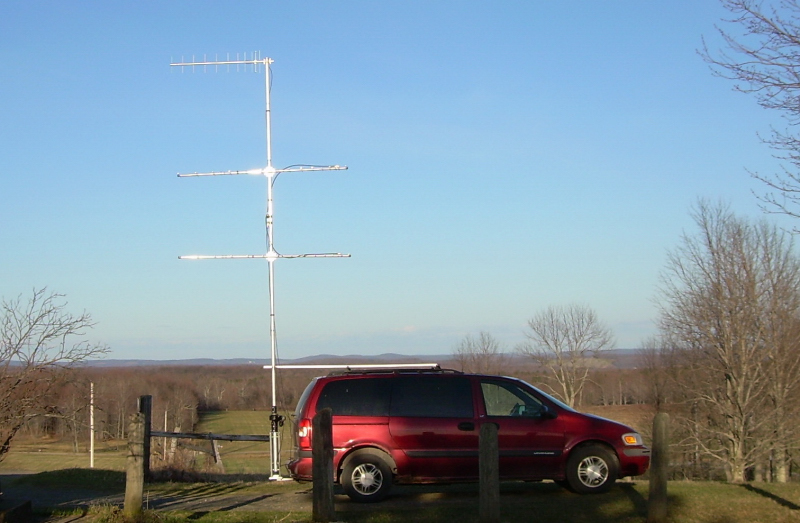432 SPRING SPRINT 2015
SINGLE OPERATOR LOW POWER (hilltop portable)
ANTENNA SYSTEM
2-stack of Directive Systems and Engineering DSFO432-15RS "rover special" 15-el yagis
single M-squared 11-element Yagi vertically polarized for FM simplex
RADIO EQUIPMENT
Icom IC-7000 mobile
5 watts
TE Systems 4410G amplifier with preamp
50 watts
DESCRIPTION
Best sprint weather so far--temperatures were in the 60s at the start and 41 degrees when I got home. Sunny during the day
and bright moon in the clear night sky. I set up the antenna system on my local fire tower hilltop in western FN22 where
there is moderately good elevation, few signal blockages, good privacy, and lower noise levels than most other sites--all of
which make for a better 432 sprint. There was slow QSB the whole night, especially on east/west paths. But I was still able
to work 200+ miles to VA3ELE/R EN93 thanks to the operating technique of repeating information several times so that one of
those times the information will hit a QSB peak and make it through. I was able to work VA3ELE/R two more times, and he ended
up providing my only contact into EN92 also. No FM simplex contacts were made despite two tries. More than a third of my
contacts were CW. Most people were reporting worse-than-flat band conditions based on lower signal strengths than usual. My
toughest propagation was along the northeast-southwest line: K1DY/R to my northeast was completely missing in action here and
was S6 last year. W9KXI is only 105 miles to my southwest and was barely audible this year. I never heard anything beyond
adjacent grid FN11. But despite the tougher conditions this year and no 300+ mile DX like last year, I did somehow manage to
compile more Qs and grids. Best DX to the east were the stations in FN42. Best to the south was WB2RVX FM29
(194 miles / 312 km). In the last few minutes I heard KD2AVU FN30 working K1RZ FM19, and both would have been new grids and
new DX. I pointed at K1RZ, moved down a few KCs, and called CQ but didn't get him.
Here's an interesting contact in light of all the pre-contest talk regarding spotting: At one point I returned to my run
frequency after making a contact elsewhere, called CQ, and was immediately greeted by a new station who said he had been
waiting on frequency to try working me. Sounds like someone must have spotted me, resulting in a contact that may not have
happened otherwise, but at what overall cost I don't know. The time it takes to spot someone could have been used by the
spot-broadcaster to call CQ, turn the antenna, or spin the VFO which could have resulted in another contact for himself.
Similar situation for the spot-watcher sitting on a frequency wondering whether the spottee will return to calling CQ at all,
and if so, whether it will be to the same run frequency as before and still on a favorable beam heading. A spot-watcher
equipped with dual-watch function (IC-7600, for example) could benefit greatly by listening to the spotted frequency on VFO-A
in one ear and scanning the band with VFO-B in the other ear.
POINTS SUMMARY
BAND QSOs GRIDS
-----------------------------
432 21 13
--- claimed score = 273 ---
LOG
MD UTC CALLSIGN GRID
--------------------------------
PH 2304 K8ZES FN02
PH 2306 W9KXI FN12
PH 2308 N2DCH FN22
PH 2310 N3RN FN11
PH 2317 VE3YCU FN02
PH 2339 W1XM FN42
PH 2340 KA2LIM FN12
PH 2342 WZ1V FN31
PH 2344 KJ1K FN32
PH 2357 VA3ELE/R EN93
CW 0007 WB2RVX FM29
CW 0010 KC3DBG FN21
CW 0029 AA2DT FN12
CW 0040 K1TR FN42
CW 0121 K1PXE FN31
CW 0132 WA3DRC FN20
PH 0134 WA2LTM FN20
CW 0156 VA3ST FN03
CW 0226 K1TEO FN31
PH 0247 VA3ELE/R FN02
PH 0251 VA3ELE/R EN92
